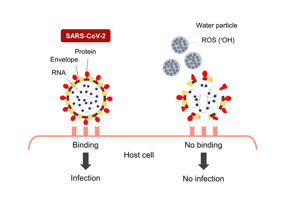Home > Press > Disinfectant mechanism of nano-sized electrostatic atomized water particles on SARS-CoV-2: Nano-sized electrostatic atomized water particles destroy SARS-CoV-2 envelope, protein, and RNA, thereby impairing the viruss ability to bind to host cells
 |
| When the envelope, protein, and RNA of SARS-CoV-2 are damaged by nano-sized electrostatic atomized water particles, the virus is unable to bind to host cells.
CREDIT Osaka Metropolitan University |
Abstract:
Current disinfection strategies have major drawbacks, which is why the World Health Organization does not advise routine spraying or fogging of biocidal agents, or UV light sterilization, in occupied areas. One possible alternative is nano-sized electrostatic atomized water particles generated by an electrospray device developed by Panasonic Corporation. The water particles contain reactive oxygen species (ROS) that damage lipid, protein, and DNA and are reported to disinfect several bacterial and viral species.
Disinfectant mechanism of nano-sized electrostatic atomized water particles on SARS-CoV-2: Nano-sized electrostatic atomized water particles destroy SARS-CoV-2 envelope, protein, and RNA, thereby impairing the viruss ability to bind to host cells
Osaka, Japan | Posted on June 17th, 2022
In their previous research, Associate Professor Yasugis team showed that nano-sized electrostatic atomized water particles disinfect SARS-CoV-2, but the mechanism remained a mystery. Their new paper published in the Journal of Nanoparticle Research describes the damage they observed when SARS-CoV-2 was exposed to the nano-sized electrostatic atomized water particles.
The researchers showed the atomized water particles decreased the infectivity of SARS-CoV-2 to cells while observing the damage to the virus. We observed that the nano-sized electrostatic atomized water particles damaged the viral envelope, protein, and RNA, making them unable to bind to host cells, Associate Professor Yasugi explained. The phenomena we observed are considered the main mechanism by which the nano-sized electrostatic atomized water particles disinfect SARS-CoV-2.We found that the target of the water particles is not the specific viral specific structure or specific proteins. Because the water particles impact viral envelope, protein, and RNA, they may disinfect other enveloped viral species as well.
While this proof of concept demonstrates how the nano-sized electrostatic atomized water particles destroy SARS-CoV-2, the full extent of their application remains to be seen. We dont know the precise factor destroying SARS-CoV-2; ROS in the particles may be that factor because ROS damage lipid, protein, and DNA/RNA through their oxidation. Furthermore, our studies showed the water particles disinfect SARS-CoV-2 on surfaces under closed experimental conditions. But the efficacy of the nano-sized electrostatic atomized water particles can change depending on the humidity, temperature, and other environmental factors; for this method to be practical, it would have to work in numerous environments, Associate Professor Yasugi concluded. Our future studies will focus on the ROS mechanism of action and test if the nano-sized electrostatic atomized water particles are effective against airborne SARS-CoV-2.
####
About Osaka Metropolitan University
Osaka Metropolitan University is a new public university established in April 2022, formed by merger between Osaka City University and Osaka Prefecture University. For more research news visit https://www.upc-osaka.ac.jp/new-univ/en-research/research/ or follow @OsakaMetUniv_en and #OMUScience.
For more information, please click here
Contacts:
Jens Herzog
Osaka Metropolitan University
Copyright © Osaka Metropolitan University
If you have a comment, please Contact us.
Issuers of news releases, not 7th Wave, Inc. or Nanotechnology Now, are solely responsible for the accuracy of the content.
News and information
![]()
Solving the puzzle of 2D disorder: An interdisciplinary team developed a new method to characterize disorder in 2D materials June 17th, 2022
![]()
Photonic integrated erbium doped amplifiers reach commercial performance: Boosting light power revolutionizes communications and autopilots June 17th, 2022
![]()
OCSiAl expands its graphene nanotube production capacities to Europe June 17th, 2022
Possible Futures
![]()
Scientists offer solutions for risky tap water June 17th, 2022
![]()
Solving the puzzle of 2D disorder: An interdisciplinary team developed a new method to characterize disorder in 2D materials June 17th, 2022
![]()
Photonic integrated erbium doped amplifiers reach commercial performance: Boosting light power revolutionizes communications and autopilots June 17th, 2022
![]()
OCSiAl expands its graphene nanotube production capacities to Europe June 17th, 2022
Nanomedicine
![]()
New nano-gel to protect children receiving chemotherapy from hearing loss June 17th, 2022
![]()
Electron-phonon coupling assisted universal red luminescence of o-phenylenediamine-based CDs June 10th, 2022
![]()
Small materials may be key to reducing cardiovascular disease deaths, researchers say June 10th, 2022
![]()
Decoding a key part of the cell, atom by atom June 10th, 2022
Discoveries
![]()
New nano-gel to protect children receiving chemotherapy from hearing loss June 17th, 2022
![]()
Scientists offer solutions for risky tap water June 17th, 2022
![]()
Solving the puzzle of 2D disorder: An interdisciplinary team developed a new method to characterize disorder in 2D materials June 17th, 2022
![]()
UBCO researchers change the game when it comes to activity tracking: Flexible, highly sensitive motion device created by extrusion printing June 17th, 2022
Announcements
![]()
UBCO researchers change the game when it comes to activity tracking: Flexible, highly sensitive motion device created by extrusion printing June 17th, 2022
![]()
Photonic integrated erbium doped amplifiers reach commercial performance: Boosting light power revolutionizes communications and autopilots June 17th, 2022
![]()
OCSiAl expands its graphene nanotube production capacities to Europe June 17th, 2022
Interviews/Book Reviews/Essays/Reports/Podcasts/Journals/White papers/Posters
![]()
Controlled synthesis of crystal flakes paves path for advanced future electronics June 17th, 2022
![]()
Scientists offer solutions for risky tap water June 17th, 2022
![]()
Organic water splitters get a boost June 10th, 2022
Nanobiotechnology
![]()
New nano-gel to protect children receiving chemotherapy from hearing loss June 17th, 2022
![]()
Decoding a key part of the cell, atom by atom June 10th, 2022










